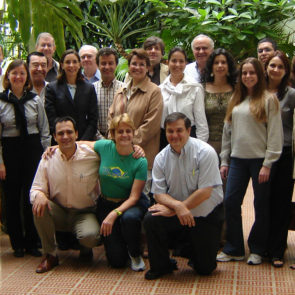
Previous Researchers
Founding Researchers:
James Austin, Harvard Business School.
Gustavo Herrero, Harvard Business School.
Previous Researchers:
Rafael Águila, Pontificia Universidad Católica de Chile.
Daniel Arenas, ESADE Business & Law School.
Guillermo Arnaudo, Universidad de San Andrés.
Julio Ayca, INCAE Business School.
Mónica Azofeifa, INCAE Business School.
Andrés Barragán, Universidad de los Andes.
Gabriela Bearzi, Universidad de San Andrés.
Mónica Bose, Universidad de São Paulo.
Tania Casado, Universidad de São Paulo.
Martha Chávez, Universidad del Pacífico.
Michael Chu, Harvard Business School.
Daniel Chudnovsky, Universidad de San Andrés.
Forrest Colburn, INCAE Business School.
Victoria Corti Maderna, Universidad de San Andrés.
Adrian Darmohraj, Universidad de San Andrés.
Paulo da Rocha Borba, Universidad de São Paulo.
Elsa del Castillo, Universidad del Pacífico.
Álvaro J.Delgado, Universidad del Pacífico.
Héctor Díaz‐Sáenz, EGADE Business School.
Verónica Durana, Universidad de los Andes.
Marisa Eboli, Universidad de São Paulo.
Guillermo S. Edelberg, INCAE Business School.
Vanina Farber, Universidad del Pacífico.
Diana Fernández, Universidad de los Andes.
Rosa María Fischer, Universidade de São Paulo.
Juliano Flores, INCAE Business School.
Fernando Frydman, Universidad de San Andrés.
Henry Gómez Samper, Instituto de Estudios Superiores de Administración.
Carolina Gowland, Universidad de San Andrés.
Norma Hernandez, EGADE Business School.
Jorge Herrera, Pontificia Universidad Católica de Chile.
John Ickis, INCAE Business School.
Ariel Kievsky, Universidad de San Andrés.
Mladen Koljatic, Pontificia Universidad Católica de Chile.
Laura Lamolia, ESADE Business & Law School.
Francisco Leguizamon, INCAE Business School.
Mateo Lesizza, INCAE Business School.
Ivan Darío Lobo, Universidad de los Andes.
Angel Maass, EGADE Business School.
Patricia Márquez, Instituto de Estudios Superiores de Administración.
Luciana Rocha Mendonça, Universidad de São Paulo.
Michael Metzger, INCAE Business School.
Christopher Moxon, EGADE Business School.
Elidia María Novaes, Universidad de São Paulo.
Enrique Ogliastri, INCAE Business School.
Luz E. Orozco, Universidad de los Andes.
Maria Parareda, ESADE Business & Law School.
Felipe Pérez, INCAE Business School.
Ramón Pinango, Instituto de Estudios Superiores de Administración.
Manuela Plaza, Instituto de Estudios Superiores de Administración.
Sergio Postigo, Universidad de San Andrés.
Julio Sergio Ramirez, INCAE Business School.
Cecilia Rena, Universidad de San Andrés.
Jesus Revilla, INCAE Business School.
José Rivera, Universidad de São Paulo.
Eric F. Rodriguez, Universidad de los Andes.
Mario Roitter, Universidad de San Andrés.
Carlos Romero, EGADE Business School.
Jaime A. Ruiz, Universidad de los Andes.
Raul Sanabria, Universidad de los Andes.
Cynthia Sanborn, Universidad del Pacífico.
Luis E. Sanchez, Universidad de San Andrés.
Loretta Serrano, EGADE Business School.
Angel Saz‐Carranza, ESADE Business & Law School.
Luana Schoenmaker de Pedreira, Universidad de São Paulo.
Mónica Silva, Universidad de São Paulo.
Ruth Szvarc, Universidad de San Andrés.
Maria Fernanda Tamborini, Universidad de San Andrés.
Joao Teixeira Pires, Universidad de São Paulo.
Marcus Thiell, Universidad de los Andes.
Ana Lucia Trujillo, Universidad de los Andes.
Elsa Margarita Uribe, Universidad de los Andes.
Lourdes Urriolagoitia, ESADE Business & Law School.
Bart Van Hoof, Universidad de los Andes.
Natalia Vasquez, INCAE Business School.
Horacio Viana, Instituto de Estudios Superiores de Administración.
Marc Vilanova, ESADE Business & Law School.
Maria Cristina Wirth, Universidad de San Andrés.
Decio Zylbersztajs, Universidad de São Paulo.
* The universities listed next to each of the researchers are the ones they were associated to when they participated in the SEKN network.